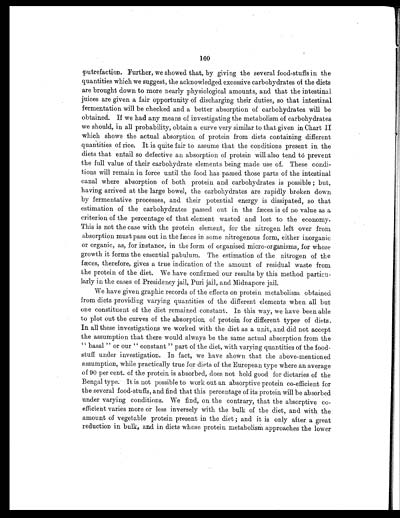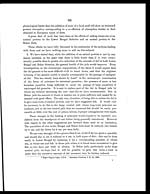Medicine - Institutions > Army health reports and medical documents > Scientific memoirs by officers of the Medical and Sanitary Departments of the Government of India > Number 37 - Investigations on Bengal jail dietaries > Part I > Chapter II - Nutritive value of Bengal jail dietaries
(170) Page 160
Download files
Individual page:
Thumbnail gallery: Grid view | List view

160
putrefaction. Further, we showed that, by giving the several food-stuffs in the
quantities which we suggest, the acknowledged excessive carbohydrates of the diets
are brought down to more nearly physiological amounts, and that the intestinal
juices are given a fair opportunity of discharging their duties, so that intestinal
fermentation will be checked and a better absorption of carbohydrates will be
obtained. If we had any means of investigating the metabolism of carbohydrates
we should, in all probability, obtain a curve very similar to that given in Chart II
which shows the actual absorption of protein from diets containing different
quantities of rice. It is quite fair to assume that the conditions present in the
diets that entail so defective an absorption of protein will also tend to prevent
the full value of their carbohydrate elements being made use of. These condi-
tions will remain in force until the food has passed those parts of the intestinal
canal where absorption of both protein and carbohydrates is possible; but,
having arrived at the large bowel, the carbohydrates are rapidly broken down
by fermentative processes, and their potential energy is dissipated, so that
estimation of the carbohydrates passed out in the fæces is of no value as a
criterion of the percentage of that element wasted and lost to the economy.
This is not the case with the protein element, for the nitrogen left over from
absorption must pass out in the fæces in some nitrogenous form, either inorganic
or organic, as, for instance, in the form of organised micro-organisms, for whose
growth it forms the essential pabulum. The estimation of the nitrogen of the
fæces, therefore, gives a true indication of the amount of residual waste from
the protein of the diet. We have confirmed our results by this method particu-
larly in the cases of Presidency jail, Puri jail, and Midnapore jail.
We have given graphic records of the effects on protein metabolism obtained
from diets providing varying quantities of the different elements when all but
one constituent of the diet remained constant. In this way, we have been able
to plot out the curves of the absorption, of protein for different types of diets.
In all these investigations we worked with the diet as a unit, and did not accept
the assumption that there would always be the same actual absorption from the
"basal" or our "constant "part of the diet, with varying quantities of the food-
stuff under investigation. In fact, we have shown that the above-mentioned
assumption, while practically true for diets of the European type where an average
of 90 per cent. of the protein is absorbed, does not hold good for dietaries of the
Bengal type. It is not possible to work out an absorptive protein co-efficient for
the several food-stuffs, and find that this percentage of its protein will be absorbed
under varying conditions. We find, on the contrary, that the absorptive co-
efficient varies more or less inversely with the bulk of the diet, and with the
amount of vegetable protein present in the diet; and it is only after a great
reduction in bulk, and in diets whose protein metabolism. approaches the lower
Set display mode to: Large image | Zoom image | Transcription
Images and transcriptions on this page, including medium image downloads, may be used under the Creative Commons Attribution 4.0 International Licence unless otherwise stated. ![]()
| Permanent URL | https://digital.nls.uk/75033225 |
|---|




